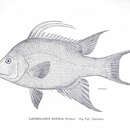mk
имиња во трошки


Description: Body relatively thin, short and wide with a large eye and a terminal, small mouth. Pectoral and pelvic fins short. Dorsal and anal-fin bases relatively long, caudal peduncle short and wide. By the time the fin-ray complement has formed, around 5.5 mm SL, melanophores are scattered over the body and in three discrete patches along the anal-fin base. Subsequently, melanophores develop in bars radiating from the eye: forward across the jaw, a vertical below the eye, and in bands across the top of the head. A reticulated pattern of melanophores then develops over the body. Since the larvae were raised in captivity, the point of transition cannot be determined. Series of larvae shows the eye remains round.
Analogues: In most features this larval type resembles larval Doratonotus megalepis, but is distinguished by a slightly different fin-ray count and, most conspicuously, by having extensive melanophore patterns on the body. The arrangement of melanophores on the head resembles that of transitional D. megalepis and they share the markings on the first dorsal-fin spines and pelvic fins, but even late transitional D. megalepis do not have the reticulated patterns on the body.
Diagnosis: The fin-ray count of D-XIV,11 A-III,10 indicates Lachnolaimus maximus. I have not collected this species, but Colin (1982) raised the larvae through their larval phase. The larvae resemble Doratonotus megalepis in basic form, but develop surface melanophores early in development, around the time the fin rays are fully formed (about 5 mm SL). This feature is particularly unusual for labrids (or other labroids) and it is likely that this species is the sole member of the family to have body pigmentation (none of the Indo-Pacific labroid larvae identified by Leis and Carson-Ewart (2000) have this character). The adaptation suggests that larval L. maximus are associated with drift algae and not exposed in the plankton.